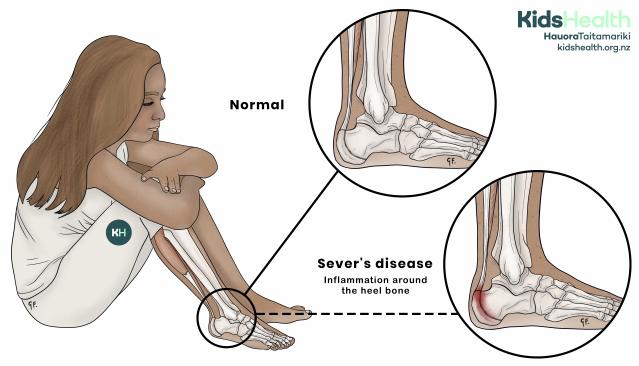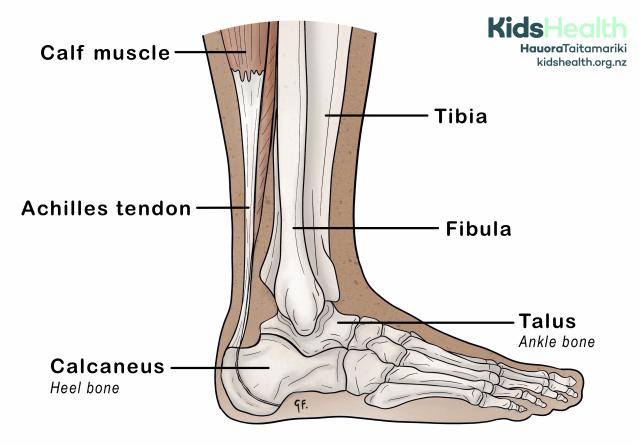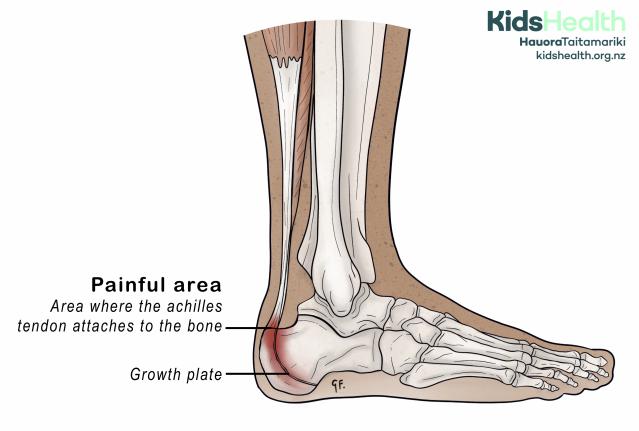Key points about Sever's disease in children
- Sever’s disease is a common cause of heel pain in active tamariki
- symptoms include heel pain, swelling, and difficulty walking
- it’s not a serious condition and usually resolves with rest, time and simple treatments
- treatment involves rest, ice and pain relief

An illustration showing what Sever’s disease looks like in the heel of a child, highlighting the area of inflammation.
Source: KidsHealth
transcribeTranscript
The illustration shows a child sitting with her knees pulled to her chest. Her lower leg is semi-transparent to show the bones and tendons inside.
A circle highlights the heel area, with two close-up views:
- Normal heel: heel bones look normal and not irritated.
- Sever’s disease: shows red inflammation at the back of the heel.
- Label: 'Sever’s disease – Inflammation around the heel bone'.
At the top right is the KidsHealth logo with the website: kidshealth.org.nz.
What is Sever's disease?
Sever’s disease is the most common cause of heel pain in tamariki and rangatahi (young people). Sever's disease is also known as calcaneal apophysitis.
Sever’s disease happens when there is stress on the growth plate of the heel bone. Stress on the heel bone can occur with repetitive activities like running or jumping.
A bit about the heel
The heel is the back part of the foot. The back of the foot includes the:
- heel bone (calcaneus)
- ankle bone (talus)
- Achilles tendon (attaches the calf muscle to the heel bone)
Muscles, ligaments, and tendons help keep the bones in the foot together.

This illustration shows the main bones, muscles, and tendons around the ankle and heel.
Source: KidsHealth
transcribeTranscript
A labelled anatomical side view of the lower leg and foot shows the:
- Calf muscle
- Achilles tendon
- Tibia
- Fibula
- Talus (ankle bone)
- Calcaneus (heel bone)
At the top right is the KidsHealth logo with the website: kidshealth.org.nz.
Symptoms of Sever's disease
Tamariki with Sever’s disease may experience:
- pain in one or both heels
- heel pain that comes on during physical activity
- heel pain that worsens after physical activity
- swelling in the heel
Tamariki with Sever’s disease may limp or walk on their tiptoes to avoid heel pain.
Who gets Sever's disease
Sever’s disease usually affects tamariki aged between 8 and 12 years. It's more common in tamariki who are very active and play sports that involve a lot of running and jumping.
Sever’s disease is uncommon in older rangatahi as the heel bone usually finishes growing by 15 years of age.
Causes of Sever's disease
Repetitive stress to the growth plate of the heel bone is what causes Sever's disease. It often occurs in active tamariki during growth spurts. During growth spurts, the bones, muscles and tendons are changing.
The pain in Sever’s disease happens where the Achilles tendon attaches to the heel bone. This area can become sore and swollen.

This illustration shows where pain happens in Sever’s disease—around the heel bone.
Source: KidsHealth
transcribeTranscript
A cross-section of the back of a foot and ankle is shown, highlighting the heel area.
- The Achilles tendon is shown connecting the calf muscle to the heel bone.
- A red, irritated area at the back of the heel is labelled: 'Painful area – Area where the Achilles tendon attaches to the bone.'
- The ankle growth plate is also labelled.
At the top right is the KidsHealth logo with the website: kidshealth.org.nz.
When to see a health professional for Sever's disease
If your child has ongoing heel pain, take them to a health professional. The health professional will ask you questions and examine your child.
Diagnosing Sever's disease
There are no specific tests to diagnose Sever’s disease. A health professional can diagnose Sever’s disease. They can do this based on your child’s symptoms and by examining the foot.
A health professional may arrange an x-ray for your child to rule out other causes of heel pain.
Treatments for Sever's disease
Treatment for Sever’s disease focuses on managing pain and reducing inflammation.
Rest and ice
Encourage your child to rest and avoid any activities that cause them heel pain. Putting ice on the heel for 15 to 20 minutes at a time may help relieve their pain.
Physiotherapy
A physiotherapist can give your child calf muscle and Achilles tendon exercises. These will help strengthen the muscles around the heel to relieve pain.
Footwear
It is important that your child has supportive footwear. especially for sports and activity. A health professional may recommend that your child have orthotics (such as gel heel cups). Orthotics are special inserts that sit inside the shoe. Orthotics can help reduce the pressure on the heel.
Pain relief
Short courses of pain relief medicine may be helpful for bad flares of pain. Your child shouldn't use pain relief for long periods of time. Talk to a health professional about how long and when to use pain relief.
Paracetamol
If your child has pain, you can give paracetamol to make them more comfortable. You must follow the dosage instructions on the bottle. It is dangerous to give more than the recommended dose.
Other medicine
Your doctor may give your child ibuprofen (such as Nurofen or Fenpaed). You can also buy it at the pharmacy. Follow the dosage instructions carefully. It is dangerous to give more than the recommended dose. Never give your child aspirin. Aspirin can increase the risk of Reye syndrome, which is a rare and serious illness.
How to help your child with Sever's disease
Here are some things you can try at home to help manage your child’s heel pain.
Watch their activity
Ensure your child gets enough rest and avoids activities that worsen their heel pain. Help them ease back into physical activities as their symptoms improve.
Prepare before activity
You can help your child prepare themselves before sports or activities. This includes making sure they have the right shoes for that activity. Also, encouraging them to stretch before and after any sports or activities can help.
Exercises
The physiotherapist may give your child exercises. These exercises help to strengthen the muscles around their heel. Encourage your child to do these and build them into their routine.
How long Sever's disease lasts
Sever’s disease usually resolves on its own as the growth plates finish developing. Sever's disease has gotten better in most tamariki by the time they are 15 years old.
With the right treatment, symptoms often get better over a few weeks to months. But for some tamariki, pain can come back, especially if they return to activities too soon.
Tamariki will not have any long-term problems because of Sever’s disease.
When to see a health professional urgently
See a health professional urgently if your child:
- has severe pain
- is unable to put any weight through their foot due to pain
- has injured their foot
- has ongoing pain despite having pain relief medicine
- has significant swelling, redness or heat around the foot area
- has a fever, loss of appetite or weight loss with the pain
Acknowledgements
Illustrations by Dr Greta File. Property of KidsHealth.
